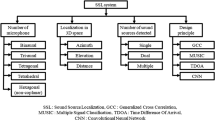Abstract
2-D sound localization can be carried out by extracting a number of features, known as localization cues, from two received left and right signals. This paper presents the measurement results obtained from three cue extraction chips implemented using standard 0.8 μm double-poly double-metal CMOS technology (threshold voltage: 0.8 V) and operating at a supply voltage of ±0.9 V. The chips consist of an onset detector which determines those portions of the received waveform which contain primarily incident (as opposed to echo) information, a spectral cue front-end and a time delay estimator used for the extraction of spectral cues and time delay cues, respectively. Some test results from each chip are first presented, together with measured cue values. The response of the complete system, with different source locations and under different noise and input signal conditions is then investigated. Results show that 2-D localization accuracy of 5° is possible using hardware-extracted localization cues. The performance of the onset detector in reducing errors arising from echo interference is also assessed. Finally, the localization performance of the system using different sound sources is presented. To our knowledge, these are the first test results obtained from such an analog hardware for a 2-D sound localization system.
Similar content being viewed by others
References
J.G. Harris, C.J. Pu, and J.C. Principe, “A Monaural cue sound localizer.” Analog Integrated Circuits and Signal Processing, vol. 23, pp. 163–172, 2000.
L. Rayleigh, “On our perception of sound direction.” Philosophical Magazine, vol. 13, pp. 214–232, 1907.
P.M. Zurek, “Anote on onset effects in binaural hearing.” Journal of the Acoustic Society of America, vol. 93, pp. 1200–1201, 1993.
G.F. Kuhn, “Physical acoustics and measurements pertaining to directional hearing,” in Directional Hearing, W.A. Yost and G. Gourevitch (Eds.), Springer-Verlag, 1987, pp. 3–25.
J.C. Middlebrooks, “Narrow-band sound localization related to external ear acoustics.” Journal of the Acoustic Society of America, vol. 92, pp. 2607–2624, 1992.
C. Lim and R.O. Duda, “Estimating the azimuth and elevation of a sound source from the output of a cochlear model,” in Proceedings of the 28th Asilomar Conference on Signals, Systems and Computers, Pacific Grove, CA, 1994, pp. 399–403.
P. Zakarauskas and M.S. Cynader, “A computational theory of spectral cue localization.” Journal of the Acoustic Society of America, vol. 94, Pt. 1, pp. 1323–1331, 1993.
I. Grech, J. Micallef, and T. Vladimirova, “Low voltage programmable current mode circuit for onset detection in a sound signal,” in Proc. 8th IEEE International Conference on Electronics, Circuits and Systems, vol. 3, pp. 1119–1122, 2001.
J. Huang, H. Ohnishi, and N. Sugie, “Sound localization in a reverberant environment based on the model of the precedence effect.” J. IEEE Trans. Instrumentation and Measurement, vol. 46, pp. 842–846, 1997.
I. Grech, J. Micallef, and T. Vladimirova, “Low voltage log domain front end for the extraction of 2-D sound localization cues,” in Proc. 8th IEEE International Conference on Electronics, Circuits and Systems, vol. 3, pp. 1473–1476, 2001.
I. Grech, J. Micallef, and T. Vladimirova, “Low-voltage, SC TDM correlator for the extraction of time delay,” in Proc. 7th IEEE International Conference on Electronics, Circuits and Systems, vol. 1, 2000, pp. 112–115.
I. Grech, J. Micallef, and T. Vladimirova, “Two ±0.7 V S2I class AB fully differential memory cells,” Electronics Letters, vol. 36, pp. 2062–2063, 2000.
D.R. Frey, “A state-space formulation for externally linear class AB dynamical circuits.” IEEE Trans. CAS-II, vol. 46, no. 3, pp. 306–314, 1999.
I. Grech, J. Micallef, and T. Vladimirova, “±0.9 V switched capacitor multiplier with rail-to-rail input.” Electronics Letters, vol. 35, pp. 1688–1689, 1999.
I. Grech, J. Micallef, and T. Vladimirova, “Low-voltage, high-speed fully differential CMOS op amp,” in Proceedings of the 7th IEEE International Conference on Electronics, Circuits and System, vol. 1, 2000, pp. 7–11.
J. Lazzaro, “Silicon models of early audition,” Ph.D. thesis, California Institute of Technology, 1990.
N. Bhadkamkar and B. Fowler, “A sound localisation system based on biological analogy,” in Proceedings of the IEEE Inter-national Conference on Neural Networks, San Francisco, CA, 1993, pp. 1902–1907.
N. Bhadkamkar, “Binaural source localizer chip using sub-threshold analog CMOS,” in Proceedings of the IEEE International Conference on Neural Networks, Orlando, FL, 1994, pp. 1866–1870.
W.G. Gardner and K. Martin, “HRTF measurements of a KEMAR.” Journal of the Acoustic Society of America, vol. 97, pp. 3907–3908, 1995.
Author information
Authors and Affiliations
Rights and permissions
About this article
Cite this article
Grech, I., Micallef, J. & Vladimirova, T. Analog CMOS Chipset for a 2-D Sound Localization System. Analog Integrated Circuits and Signal Processing 41, 167–184 (2004). https://doi.org/10.1023/B:ALOG.0000041634.92147.0d
Issue Date:
DOI: https://doi.org/10.1023/B:ALOG.0000041634.92147.0d




